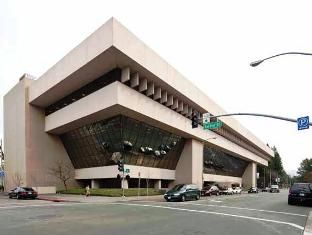Arnold’s state building-sale scheme returns
by Katy Grimes | July 25, 2013 9:43 am
A complex 2010 Schwarzenegger administration plan to sell 11 state-owned properties and then lease them back from the new owners was compared at the time to a short-term money raising gimmick.
The state of California had the 11 properties up for sale for nearly $2 billion. The sales proceeds were estimated to be $660 million, after bond debt on the properties was retired.
 [1]
[1]Judge Joseph A. Rattigan Building in Santa Rosa
This deal started when Gov. Arnold Schwarzenegger directed the Department of General Services to sell the properties in order to raise cash for the state during the 2009-10 budget crunch. DGS prepared the property valuations and estimated sale prices, and awarded the contract to commercial real estate company CB Richard Ellis.
The Legislative Analyst’s Office reported[2] that the sale would end up costing taxpayers at least $1.4 billion over 35 years. The state would have to pay an effective interest rate of 10.2 percent to rent back the buildings, about double what the state paid on existing bonds used to build its offices.
I wrote many stories[3] about the deal, until it appeared it was dead in the water, thanks to Gov. Jerry Brown, who referred to the plan as “not prudent” after he took office in 2011.
But the flawed plan is back in the news, as a lawsuit resulting from the dead deal continues on.
The deal
The deal was so “not prudent,” former building authority official, Jerry Epstein, claimed he was terminated when he questioned the validity of it in 2010.
“With little study and without public hearings or input from the real estate experts who serve on the relevant state building authorities, Gov. Arnold Schwarzenegger and the Legislature agreed to sell 11 state office building complexes,” Epstein wrote in a column[4] in the Los Angeles Times, describing the property sales as a “fire sale” during one of the biggest real estate slumps in California history.
Indeed, since then real estate prices have bounced back across the state. And this week Zillow reported [5]that home prices in Sacramento jumped 30 percent over a year ago. Although government buildings are not homes, appreciation in their value would be something similar.
Epstein
Back in 2010, I spoke[6] with Epstein, who had served since 1983 on the Los Angeles State Building Authority. He said that, even if the state gets the price it’s hoping for on the buildings, the estimated net proceeds of about $650 million would be enough to cover only a few years’ worth of future rent payments.
But the Schwarzenegger administration never contacted Epstein or the building authority about the sale.
The sale of the 11 state properties was going to be a very good deal for someone, as most of the properties were about to be paid off, and were being sold in a down-market.
I also spoke to several real estate experts specifically concerned with the draft form lease. The lease included what one real estate expert referred to as a “payoff for the SEIU” — purchasers of the properties would have been required to pay the trades (janitors, security guards etc.) a set percentage of their total state of California compensation package for the same classes of workers, even if it was far higher than the “prevailing wages.”
Flash forward
When it looked as if the sale of the 11 properties was going to go through, a lawsuit was brought by three former state building authority members, terminated by the Schwarzenegger administration: Epstein, Don Casper and A. Redmond Doms. They said that, not only were the sales a waste of taxpayer money, the sales of the properties were unconstitutional because the sales were a gift of public funds.
The lawsuit alleges, “Once the sale closes, the state will no longer own the properties at issue and will be contractually obligated, under oppressive terms, to pay a private landlord above-market rent for a period of at least 20 years, costing taxpayers billions in the long-term.”
After a Superior Court Judge had approved the sale, a California Appeals Court halted it.
Then the investors group sued the state, charging Gov. Jerry Brown with improperly canceling the sale right after taking office.
“A judge denied the state’s motion to dismiss and will allow California First LP to seek monetary damages equal to the amount the group would have earned had the deal gone through,” the Sacramento Bee reported[7] this week. “The state is ‘considering our options,’ said Eric Lamoureux, spokesman for the state Department of General Services. ‘We are evaluating the judge’s ruling and determining our next steps.’ ”
The lawsuit
Now this investment group is suing the state because the sale didn’t go through and is asking a judge to give them the profits they claim they would have made if they had been allowed to buy the state buildings at fire sale prices, and sell them now or later for a significant profit.
In February 2011, I summed up the deal[8]: “Every step of the way, it appeared that the Department of General Services and someone in the Schwarzenegger administration had a plan in mind for the property sales, that no one was going to derail. It looks as though Jerry Brown just isn’t buying into their plan.”
- [Image]: http://calwatchdog.com/wp-content/uploads/2013/07/Rattigan-state-office-building-50-D-St.jpg
- reported: http://www.lao.ca.gov/reports/2010/edu/sale_leaseback/sale_leaseback_042710.aspx
- wrote many stories: http://calwatchdog.com/page/3/?s=state+buildings+for+lease
- wrote in a column: http://articles.latimes.com/2010/apr/06/opinion/la-oe-epstein6-2010apr06
- Zillow reported : http://www.sacbee.com/2013/07/23/5587395/sacramento-area-home-prices-jump.html
- spoke: http://calwatchdog.com/new-critics-slam-state-property-sale/
- reported: http://blogs.sacbee.com/capitolalertlatest/2013/07/state-weighing-options-in-lawsuit-over-office-building-sale.html#storylink=cpy
- February 2011, I summed up the deal: http://calwatchdog.com/gov-brown-halts-state-building-sale/#sthash.2G5B1a1T.dpuf
Source URL: https://calwatchdog.com/2013/07/25/arnolds-state-building-sale-scheme-returns/